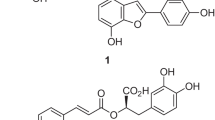Abstract
Kinka-cha (dried leaf of Camellia nitidissima) is used as a folk tea for detoxication, diuresis and antihypertension. In the present study, we evaluated the extract of kinka-cha on metabolic, vascular and oxidative stress parameters in a model of metabolic syndrome, SHR/NDmcr-cp/cp (SHR/cp) rats that manifest hypertension, obesity, glucose intolerance and hyperlipidemia. Treatment with the extract of kinka-cha alleviated the increase in blood pressure, decrease in tail blood flow and elevated serum oxidative stress marker levels including lipid peroxides, 8-hydroxy-2′-deoxyguanosine, 3-nitrotyrosine and 3-chlorotyrosine. However, kinka-cha did not affect weight gain, hyperglycemia and hyperlipidemia, nor the relaxation responses of the aorta mesenteric artery, thoracic aortas and tail vein, and blood clotting and platelet aggregation. These results suggest that kinka-cha can help reduce the risk of developing metabolic syndrome, possibly due to the presence of antioxidants.





Similar content being viewed by others
References
Michaelis OE, Ellwood KC, Judge JM, Schoene NW, Hansen CT (1984) Effect of dietary sucrose on the SHR/N-corpulent rat: a new model for insulin-independent diabetes. Am J Clin Nutr 39:612–618
Striffler JB, Bhathena SJ, Micaelis OE IV, Campbell JD, Hansen CT, Scalbert E, Thibault N, Velasquez MT (1998) Role of angiotensin-converting enzyme inhibition in glucose metabolism and renal injury in diabetes. Metabolism 47:1199–1204
Nagase M, Fujita T (2010) Mineralocorticoid receptor activation in obesity hypertension. Hypertens Res 32:649–657
Yamaguchi Y, Yoshikawa N, Kagota S, Nakamura K, Haginaka J, Kunitomo M (2006) Elevated circulating levels of markers of oxidative-nitrative stress and inflammation in a genetic rat model of metabolic syndrome. Nitric Oxide 15:380–386
Kagota S, Yamaguchi Y, Tanaka N, Kubta Y, Kobayashi K, Nejime N, Nakamura K, Kunitomo M, Shinozuka K (2006) Disturbances in nitric oxide/cyclic guanosine monophosphate system in SHR/NDmcr-cp rats, a model of metabolic syndrome. Life Sci 78:1187–1196
Kudo M, Noshiro M, Aoyama Y, Yoshida Y (2004) Studies on the expression levels of sterol-metabolizing enzymes in the obese model SHR/NDmcr-cp rats. Clin Exp Pharmacol Physiol 34:S57–S59
Harikai N, Hashimoto A, Semma M, Ichikawa A (2007) Characteristics of lipolysis in white adipose tissues of SHR/NDmc-cp rats, a model of metabolic syndrome. Metab Clin Exp 56:847–855
Oku H, Ogawa Y, Iwaoka E, Ishiguro K (2007) Development of an in vivo bioassay method for primary preventive substances of the metabolic syndrome—effect of kinginka-cha. Clin Exp Pharmacol Physiol 34:S40–S42
Huang Y, Wen Y, Chen Y, Tang W, Li D, Liu J, Wei X (2009) Extraction technology and dynamic change of flavonoids in Camellia nitidissima leaves. Shipin Kexue 30:72–75
Huang Y, Chen Y, Wen Y, Li D, Liu J, Wei X (2009) Analysis of volatile components in Camellia nitidissima by GC-MS. Shipin Keji 34:257–260
Liang J, Yang Z, Lu T, Huang S (1999) Evaluation on tea-process fitness of eight yellow Camellias based on tea polyphenols and amino acids. Guangxi Sci 6:72–74
Yagi K (1976) A simple fluorometric assay for lipoperoxide in blood plasma. Biochem Med 15:212–216
Long L, McCabe DR, Dolan ME (1999) Determination of 8-oxoguanine in human plasma and urine by high-performance liquid chromatography with electrochemical detection. J Chromatogr B Biomed Sci Appl 731:241–249
Ishiguro K, Oku H, Ueda Y, Iwaoka E, Kunitomo M (2005) Development of an in vivo bioassay method for allergy-preventive substances using hen-egg white lysozyme (HEL)-induced blood flow decrease. Biol Pharm Bull 28:1490–1495
Ogawa Y, Oku H, Iwaoka E, Iinuma M, Ishiguro K (2006) Allergy-preventive phenolic glycosides from Populus sieboldii. J Nat Prod 69:1215–1217
Lind L, Lithell H (1993) Decreased peripheral blood flow in the pathogenesis of the metabolic syndrome comprising hypertension, hyperlipidemia, and hyperinsulinemia. Am Heart J 125:1494–1497
Vaziri ND, Ni Z, Oveisi F, Trnavsky-Hobbs DL (2000) Effect of antioxidant therapy on blood pressure and NO synthase expression in hypertensive rats. Hypertension 36:957–964
Eiserich JP, Hristova M, Cross CE, Jones AD, Freeman BA, Halliwell B, van der Vliet A (1998) Formation of nitric oxide-derived inflammatory oxidants by myeloperoxidase in neutrophils. Nature 391:393–397
Gaut JP, Byun J, Tran HD, Lauber WM, Carroll JA, Hotchkiss RS, Belaaouaj A, Heinecke JW (2002) Myeloperoxidase produces nitrating oxidants in vivo. J Clin Invest 109:1311–1319
Acknowledgments
This research was supported by the Open Research Center Project of Mukogawa Women’s University for studying lifestyle-related disease, Japan.
Author information
Authors and Affiliations
Corresponding author
Rights and permissions
About this article
Cite this article
Oku, H., Ogawa, Y., Iwaoka, E. et al. Preventive effects of the extract of kinka-cha, a folk tea, on a rat model of metabolic syndrome. J Nat Med 65, 610–616 (2011). https://doi.org/10.1007/s11418-011-0523-0
Received:
Accepted:
Published:
Issue Date:
DOI: https://doi.org/10.1007/s11418-011-0523-0




